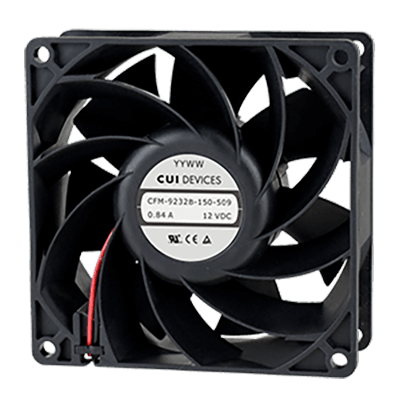What Is a DC Fan Motor?

DC fan motors are motors that rotate fans and are driven by DC current.
DC fan motors are broadly classified into propeller fans, blowers, cross-flow fans, and other types according to their structure, but they all have the same thing in common: they blow air.
Therefore, it is important to check the catalog specifications and choose the right one for your application and purpose. The most common type of fan motor is a propeller fan, so if you are not sure which one to choose, it is safe to select this one.
Uses of DC Fan Motors
DC fan motors are used to cool the inside of electronic equipment, such as home appliances and office automation equipment, by blowing or convecting air through fan rotation.
When the temperature rises, not only does it cause thermal runaway of electronic equipment, but it is also prone to cause malfunctions. Cooling by DC fan motors is based on air convection, so the most efficient method must be selected in consideration of the structure of the equipment and its temperature.
Principle of DC Fan Motors
The structure of a DC fan motor can be roughly divided into a casing for the structural components, a fan or runner for airflow, and a DC motor for turning the fan or runner.
In the case of a propeller fan, the direction of airflow is the same as the axis of rotation, resulting in a small size, large air volume, and relatively quiet rotation. In contrast, a blower is perpendicular to the axis of rotation, and the outlet of the airflow is narrowed down to concentrate the airflow and obtain high static pressure.
Structure of DC Fan Motors
A typical fan consists of an impeller, casing, main shaft, bearings, and shaft seal.
1. Impeller
The impeller is the part that produces the airflow and is the heart of the fan. There are various types of impellers depending on the application, environment, and other factors related to the efficiency of airflow.
2. Casing
The casing is the part that forms the outer frame of the fan itself and the inner air flow path, and is the part that forms the suction and discharge parts of the fan.
3. Spindle
The central shaft of the fan, which is strong enough to support the impeller.
4. Bearing
The part that receives the rotational motion of the spindle and supports it by smoothing its action. The bearing reduces friction and wear. It is an important part because poor quality can lead to failure due to mechanical wear.
Other Information on DC Fan Motors
1. What Is Airflow Resistance?
When air is blown into a channel, airflow resistance occurs in the opposite direction to the direction in which the air moves in the channel. The more obstacles there are in the flow path that block airflow, the greater the airflow resistance and the lower the airflow. Airflow resistance is energy that increases the static pressure inside the equipment and is also called pressure drop.
In the case of cooling by fan, since airflow resistance is generated, it is necessary to select the performance of the fan in consideration of pressure loss due to the internal structure. Also, considering cooling by a fan, it is important to design the structure so that it does not interfere with airflow.
When multiple fans are used to obtain the required air volume and static pressure, it is also important to consider whether it is most efficient to use them in series or parallel. In general, using fans in parallel increases airflow and using fans in series increases static pressure.
2. Difference From AC Fan Motors
DC fan motors can vary their rotational speed with the motor and circuitry. On the other hand, AC fans have their rotation speed fixed by the frequency of the AC power supply. Currently, DC fans that can freely control the rotation speed are the mainstream, and there are also ACDC fans that rotate DC fans with an AC power supply.
3. What Is a DC Axial Flow Fan?
DC axial fans are DC-driven axial fans. The axial fan has blades mounted in the center of the frame, and air is drawn in from the front of the blades and discharged to the rear.
The direction in which the fan sends air is in the axial direction, which has the advantages of high airflow and low noise. It is widely used for cooling applications for materials that generate heat. Relatively little increase or decrease in airflow due to resistive objects is a characteristic of axial fans.
4. Other Types of Fans
Other types of axial fans include centrifugal fans and oblique flow fans. Centrifugal fans send air not backward but 90 degrees from the direction of suction.
Also, the oblique flow fan is a kind of fan between the axial flow fan and the centrifugal fan. The shape of the blades causes air to be sucked in from the axial direction and pressure is applied in the diagonal direction of the shaft, changing the exhaust direction to send air. It is characterized by its small size and light weight.
Centrifugal fans are suitable when the space of the equipment does not allow air to be blown backward. They are used to draw air from inside densely packed equipment. A typical axial fan motor is a propeller fan. A blade-shaped propeller is placed inside the casing and rotated to generate airflow in the direction of the axis of rotation.
Since the airflow is in the direction of the axis of rotation, it has a compact structure. A typical fan motor in a centrifugal fan is a blower. The centrifugal force of the cylindrically arranged forward-facing blades of a blower creates an air flow in a direction almost perpendicular to the axis of rotation.